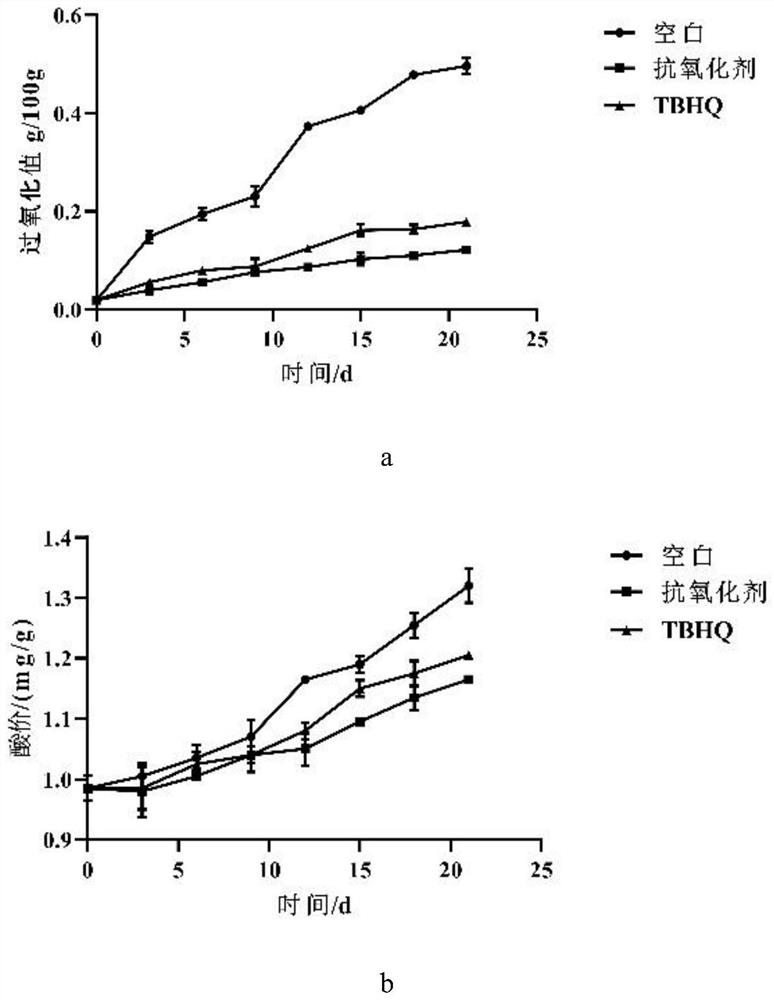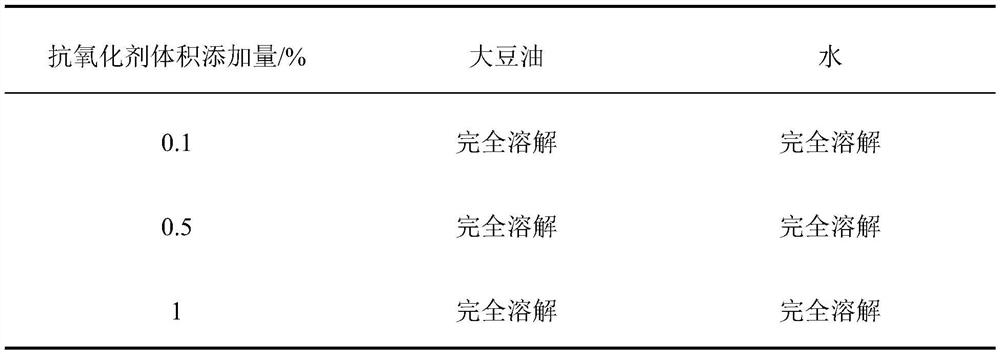Preparation method and application of water-oil amphiphilic antioxidant
An antioxidant and amphiphilic technology, which is applied in the field of food science, can solve the problems of poor use effect, decreased sensory quality of oil, poor solubility, etc., and achieve good antioxidant effect, stable product properties, and simple production process.
- Summary
- Abstract
- Description
- Claims
- Application Information
AI Technical Summary
Problems solved by technology
Method used
Image
Examples
Embodiment 1
[0013] Example 1: Solubility Determination
[0014] Accurately weigh 8012g, vitamin E 2G, rosemary extract (market purchase) 2g, slow stir, mix well to give a mixed solution; 0.1 g of tea polyphenol dissolve in 3.9 g of water, completely dissolved with 6 ml / min In the mixed solution, the mixed solution was slowly stirred to a mixed solution to show a clear transparent shape to obtain a hydrophilic duplex type antioxidant. The resulting antioxidants were dissolved in soy oil and water, respectively, and observe the sample state. According to the amount of antioxidant in the general production, it is added to soy oil and water, and the antioxidant can dissolve, and the dissolved sample is produced or precipitated.
[0015] Table 1 antioxidant solubility test
[0016]
Embodiment 2
[0017] Example 2: Stability Test
[0018] 1. Antioxidant (Example 1) was centrifuged at 3000 R / min at 3000 r / min, and no hierarchical phenomenon, and the antioxidant was uniformly stable.
[0019] 2. Antioxidant (Example 1) is placed at room temperature (about 25 ° C) to observe its state under the conditions of refrigeration (4 ° C), and there is no solute precipitation or hierarchical phenomenon within 6 months.
[0020] As can be seen from the stability test results, the antioxidants made of the method are relatively stable, and can be placed for a long time without the precipitation or hierarchical phenomenon.
Embodiment 3
[0021] Example 3: Antioxidant test
[0022] With the Schal oven, the antioxidant (Example 1 obtained) and tert-butyl diphenol (TBHQ) were studied by comparing the oxidative induction period of soybean oil, and using OxiteSt method. Effect of antioxidant properties.
[0023] Antioxidant Add: Each soybean oil sample is accurately weighted 50g, placed in a beaker, and 0.1% antioxidants in each sample, 0.02% TBHQ, each treatment repeated 3 times, while doing a blank control.
[0024] Schaal oven method: Each set of sample open is placed in a thermostatic oven of 65 ° C, and the constant temperature prevents light, accelerates oil oxidation, and the acid price of grease is determined, the peroxidation value of the oil peroxidal, and the sample is changed in the oven each time samples. The effect of different antioxidants on the antioxidant stability of soybean oils. The price of the acid price and peroxidation value reference national standard. OxiteSt Method: Accurately weigh 5G sampl...
PUM
 Login to View More
Login to View More Abstract
Description
Claims
Application Information
 Login to View More
Login to View More - R&D
- Intellectual Property
- Life Sciences
- Materials
- Tech Scout
- Unparalleled Data Quality
- Higher Quality Content
- 60% Fewer Hallucinations
Browse by: Latest US Patents, China's latest patents, Technical Efficacy Thesaurus, Application Domain, Technology Topic, Popular Technical Reports.
© 2025 PatSnap. All rights reserved.Legal|Privacy policy|Modern Slavery Act Transparency Statement|Sitemap|About US| Contact US: help@patsnap.com



